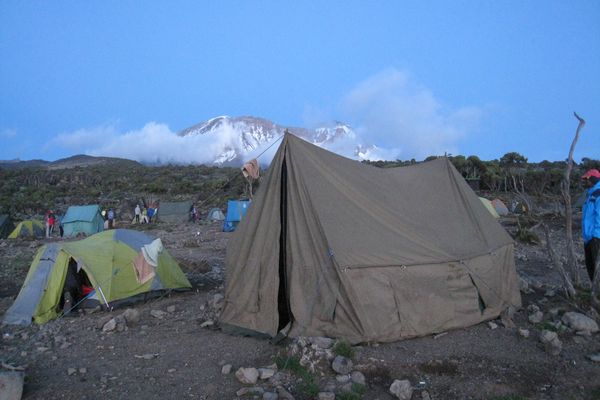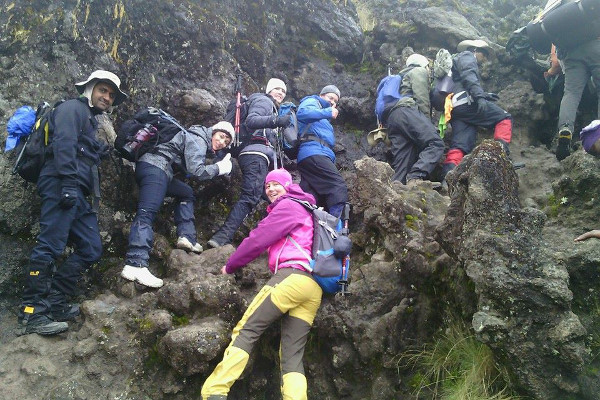This page provides a comprehensive and impartial guide to climbing Kilimanjaro via the Lemosho Route.
Lemosho Route Overview
The Lemosho Route has long been considered one of the best overall routes up Kilimanjaro.
Often completed in seven days, trekkers on the Lemosho Route have an excellent chance of reaching the summit and the path they take to get there tends to be much less busy in the first couple of days than the more-popular Machame Route.
The route approaches the mountain from the west and enjoys breathtaking and unique views from the Shira Plateau.
Later in the trek, the Lemosho Route follows the same spectacular route up the mountain as the Machame Route, past Lava Tower and the Barranco Wall. Trekkers descend via the Mweka route.
The Lemosho Route also offers trekkers the opportunity to see large wildlife in their first two days on the trail, including antelope, buffalo or even elephants!

Lemosho Route - Typical Itinerary
The Lemosho route can be completed in 6, 7 or 8 days. The 7-day option is the most popular and provides for good acclimatisation.
Below we have set out the standard route variation for the 6-day option. For the 7- and 8-day variations see the next section.
Day 1
- Distance: About 5.5km, or 3 miles
- Trekking time: 3 to 4 hours
- Change in elevation: 460 meters
- Landscape: Rainforest
The Lemosho Route begins far on the western side of Kilimanjaro. The first day of trekking begins with a two-hour drive from Moshi, or a longer drive from Arusha, to Londorossi Gate (2,100 meters), where trekkers will be introduced to their crew, which includes guides, porters and cooks. Packs are weighed to ensure they don't exceed 20 kilograms, and the porters arrange all the gear needed for the days ahead.
After checking in at the park gate, trekkers will get back into the car to travel to the trailhead, which is a further 12 kilometers. This portion of the drive can be muddy and inaccessible during the wet season, so trekkers may have to walk a portion of this distance. Assuming the road is passable, then the day's trek is a short one, with about 460 meters of elevation gain to Mti Mkubwa Camp (2,820 meters).
Trekkers should keep their eyes peeled on the way - it is possible to see elephant or buffalo on this portion of the trail, and your group may be accompanied by an armed guide for protection! Trekkers arrive to the welcome sight of a fully-assembled camp, and dinner is served.
Day 2
- Distance: About 16km, or 8.5 miles
- Trekking time: 6 to 8 hours
- Change in elevation: 1,030 meters
- Landscape: Rainforest; Low Alpine
Day Two sees trekkers making their way from Mti Mkubwa Camp (2,820 meters) to Shira Camp 2 (3,850 meters). The path takes you through scenic rainforest which gives way to low alpine meadows and moorlands. At Shira Camp 2, trekkers are rewarded with their first views of the Kibo summit, and Mount Meru is visible in the East. Temperatures can drop quite significantly here on the plateau, so trekkers should be prepared.
Day 3
- Distance: About 11km, or 7 miles
- Trekking time: 5 to 7 hours
- Change in elevation: 750 meters ascent, 700 meters descent
- Landscape: Low Alpine; High Alpine
On Day Three, a long and arduous hike is in store. Ascending from Shira Camp 2 (3,850 meters) to Lava Tower (4,600 meters) in the morning, this is a likely day to begin feeling the effects of the altitude. In the second part of the hike, the trail loses almost all of the altitude gained in the morning before ending at Barranco Camp (3,900 meters). The landscape drifts between low and high alpine zones, which are characterized by grassy moors and barren fields of volcanic rock, respectively.
Day 4
- Distance: About 9.5km, or 6 miles
- Trekking time: 8 to 10 hours
- Change in elevation: 780 meters
- Landscape: High Alpine
First thing in the morning on Day Four, trekkers are faced with an arduous scramble up the Barranco Wall, a 257 meter rock face which leads into the Karanga Valley. Once over the wall, the trail meanders towards Karanga Camp (3,960 meters). Eight-day trekkers will stop here for the night, gaining another valuable opportunity for acclimatization before their summit attempt. Trekkers on the six-day and seven-day routes will stop in Karanga Camp for lunch, then continue on towards the Mweka Trail and Barafu Camp (4,680 meters).
Day 5
- Distance: About 4.5km (3 miles) ascent and 11km (7 miles) descent
- Trekking time: 6 to 8 hours to the summit, followed by 5-8 hours of hiking to Mweka
- Change in elevation: 1,215 meters ascent, 2,795 meters descent
- Landscape: Glacial at the summit, and all preceding zones on the descent
It's summit day! However, you start hiking promptly at midnight. This is the most challenging portion of the entire route. Scrambling up a scree field in the pitch dark, many trekkers find that this is the point in the hike where they really begin to feel the effects of altitude.
Please Note: If you show serious symptoms of Acute Mountain Sickness, get help and descend as quickly as possible.
After 6-8 hours of hiking with a headlamp, you should reach the crater rim at Stella Point (5,739 meters). This is not the summit, but it is a good place to stop for some tea and to watch the sunrise. Uhuru Peak, the summit of Kilimanjaro, is another 156 meters higher. To reach it, you must traverse around the rim of the caldera. Keep going, you've already finished the hard part!
Once you've taken a few photos on the highest point in Africa, it's time to get going on the descent, which takes you another 7 miles(!) down to Mweka Camp (3,100 meters). To relieve stress on your knees, trekking poles can be very handy on the descent. At the end of the day, the rainforest surrounding Mweka Camp will be welcome relief from the inhospitable environment at the summit.
Day 6
- Distance: About 9km, or 5.5 miles
- Trekking time: 3 to 5 hours
- Change in elevation: 780 meters
- Landscape: Rainforest
During the last day on the Lemosho Route, you will descend gradually through a lush rainforest to Mweka Gate (1,640 meters). If you've reached Stella Point or Uhuru Peak on the previous day, you will be presented with an official certificate at the park gate. It is customary to tip your crew at this point, before your trip back to your hotel in Moshi or Arusha.
Lemosho Pros and Cons
Pros
- Can be completed on a 6, 7 or 8 day route variation. The latter has better summit success!
- Great Walk High, Sleep Low profile which aids acclimatisation
- Excellent summit success rates. On the 8-day variation summit success rates are about 90%
Cons
- Relatively high starting point can mean one feels the effects of altitude early on
Lemosho Altitude
The Lemosho Route has one of the better altitude profiles on Kilimanjaro for acclimatisation. Despite a relatively high start at Londorossi Gate, the ascent on the first few days is quite gradual.
The route also builds in the important Walk High, Sleep Low principle with the ascent to Lave Tower on day 3 (7-day Lemosho) or day 4 (8-day Lemosho).
Lemosho Route Variations
The Lemosho Route is also operated as a seven or eight-day trek.
For the seven-day version, trekkers spend their second night on the trail at Shira Camp 1, rather than Shira Camp 2.
Their third night is spent at Moir Hut, and the fourth night is spent at Barranco Camp.
Seven-day trekkers arrive at Barafu Camp on their fifth day, and make their summit bid on the sixth day of trekking. They descend via the Mweka route on the seventh day.
Eight-day trekkers gain another valuable day for acclimatization. The eight-day route is identical to the seven-day route, except that trekkers split the journey from Barranco Camp to Barafu Camp into two days, spending the night at Karanga Camp after scrambling up the Barranco Wall.
The eight-day version of the Lemosho Route is highly-recommended by tour operators as it gives trekkers the best chances of reaching the summit.
Lemosho Route to Kilimanajro FAQS
When is the best time to trek the Lemosho Route?
June through to September is the best time to climb Kilimanjaro via the Lemosho route. That said, since it is close to the equator it is possible to climb the mountain at any time of the year. April and May are the rainy season, so most hikers avoid these months.
How much does the Lemosho trek cost?
The average cost of a Lemosho route hike is around $2500. The costs of trekking on the Lemosho Route will vary based on a few factors, such as what season you choose to hike, whether you choose the six, seven or eight-day option, or whether you choose to use a Western guiding company or communicate directly with a local guiding company.
Here are the major costs to consider when planning to undertake the Lemosho Route:
- Visa, Vaccinations, Insurance etc: ~$300-$500
- Equipment (buying and hiring): ~$200-$300
- Flights to Kilimanjaro International Airport: ~$800
- Tour Agency: About $1,800 for a very cheap local agency (not recommended) to ~$3,500 for an expensive Western agency. You could do an independent trek for ~$1,500 employing a local guide (only recommended for experienced high altitude trekkers).
- Tips: ~$200-$300
- Misc (additional food, unplanned travel / hotels etc): $200
Total Costs: $3,200 – $5,100
Are permits required for the Lemosho hike?
A permit is required to climb Kilimanjaro, regardless of route. Furthermore, all trekkers must be accompanied by a guide and porters. If you are joining an organised tour, these will be arranged for you.
How difficult is the Lemosho Route?
The Lemosho Route is widely considered to be one of the easiest routes up Kilimanjaro. Hikers of all ages regularly reach the summit via the Lemosho Route, with a summit success rate of above 90% (on the 8-day variation). That said, it's a good idea to work on your aerobic fitness before taking on the trek. Kilimanjaro is a serious undertaking that should not be approached lightly.
Is altitude sickness a risk on the Lemosho?
The Lemosho Route is designed to allow hikers some time for acclimatization before the summit push. That said, altitude sickness is a serious concern and trekkers should be informed of the risks, symptoms and warning signs before they go.
If you are particularly concerned about altitude sickness, the eight-day Lemosho Route is probably your best chance to reach the summit as it allows ample time for acclimatization.
It is important to have a solid understanding of the risks associated with high altitude trekking and how the body acclimatises to high altitude.
See our detailed article on Altitude Sickness and Acclimatisation.
What gear do I need for the Lemosho route? (Packing List)
Trekking Mount Kilimanjaro requires a number of essential pieces of trekking clothing and equipment. You will be exposed to a range of altitudes where temperatures fluctuate dramatically between night and day.
To help you plan and prepare for your trek, we have created a detailed list of gear to climb Kilimanjaro. For more packing lists, see our Resources page, as well as detailed gear reviews.
Continue browsing
See more information on Tanzania. Or check out these other Kilimanjaro Hiking articles:

